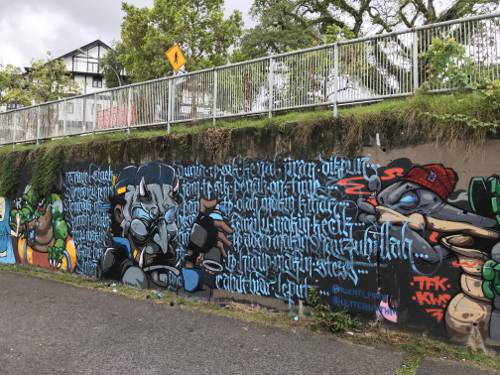
FAQ About Influence of Graffiti Typography on Street Communication

What is graffiti typography?
Graffiti typography refers to the typographic styles and techniques used in graffiti art. It includes the use of letters and words to create visual art pieces on surfaces in public spaces. These styles are often elaborate and colorful, expressing the artist's creativity and identity.

How does graffiti typography influence urban communication?
Graffiti typography influences urban communication by transforming ordinary urban surfaces into platforms for self-expression and public dialogue. It captures attention, conveys messages, and reflects social issues and local identities, often serving as a counter-cultural commentary that resonates within communities.

What are some common styles in graffiti typography?
Common styles in graffiti typography include tags, throw-ups, and pieces. Tags are simple, quick signatures of an artist. Throw-ups involve repeated shapes and designs, often using bubble letters. Pieces, or masterpieces, are complex renditions with intricate designs and colors, showcasing the artist's skill and creativity.

In what ways does graffiti typography impact visual culture?
Graffiti typography impacts visual culture by influencing design, fashion, and contemporary art. It introduces new fonts and styles that designers can incorporate into various media. Additionally, brands have adopted graffiti-inspired visuals to appeal to younger, urban audiences.

What role does graffiti typography play in cultural identity?
Graffiti typography plays a significant role in cultural identity by allowing individuals and groups to express their unique narratives and experiences. It often reflects the socio-political context of an area and can foster a sense of belonging or community for marginalized voices.

Why is graffiti typography considered a form of urban expression?
Graffiti typography is considered a form of urban expression because it often communicates messages related to social issues, personal identity, politics, or community life in a direct and relatable way. It is a tool for artists to express themselves or make statements within the urban environment.

Can graffiti typography be considered a form of fine art?
Yes, graffiti typography can be considered a form of fine art. Many artists have gained recognition for their work, which is displayed in galleries and museums worldwide. The art form's complexity, creativity, and cultural commentary contribute to its appreciation in the fine art community.

What are some challenges faced by graffiti typographers?
Graffiti typographers often face challenges such as legal issues, as graffiti is frequently associated with vandalism. They may also encounter difficulties in gaining public acceptance and overcoming negative stereotypes. Additionally, accessing safe and suitable spaces for artistic expression can be challenging.

How do city administrations typically respond to graffiti typography?
City administrations' responses to graffiti typography vary. Some cities implement strict anti-graffiti laws and quick removal policies to maintain cleanliness, while others have embraced it by designating legal graffiti walls and supporting public art initiatives to harness its creative potential.

What is the historical evolution of graffiti typography?
The historical evolution of graffiti typography began with simple inscriptions in ancient civilizations but became a distinctive art form in the late 20th century, particularly in urban areas of New York City. It evolved from basic tags to sophisticated artworks, heavily influenced by hip-hop culture.

How do graffiti typography and street art differ?
While both forms use public spaces for artistic expression, graffiti typography focuses primarily on lettering styles and word art, whereas street art encompasses a broader range of techniques and themes, including images and multimedia installations.

Can graffiti typography illegally influence public messaging?
Graffiti typography can influence public messaging both positively and negatively when applied illegally. It can raise awareness on social issues or community concerns, but unauthorized works are often viewed as vandalism, which can detract from the intended message.

Are there any famous artists known for their graffiti typography?
Yes, several artists are renowned for their graffiti typography. Notable figures include Banksy, known for his distinct stencil style and social commentary, and Jean-Michel Basquiat, who blended graffiti with fine art to critique power structures and address racial and social issues.

What materials are commonly used in graffiti typography?
Common materials used in graffiti typography include spray paint, markers, and stencils. These tools allow artists to create vibrant, dynamic designs quickly, which is crucial given the frequently illegal nature of the work requiring haste and mobility.

How has digital technology influenced graffiti typography?
Digital technology has significantly influenced graffiti typography by providing artists with new tools for designing and visualizing their works before executing them on physical surfaces. Additionally, digital platforms allow for greater dissemination and appreciation of graffiti art globally.

What impact does graffiti typography have on urban aesthetics?
Graffiti typography can greatly affect urban aesthetics, introducing vibrant color schemes and complex designs that add character to otherwise mundane or neglected cityscapes. It challenges conventional perceptions of urban beauty and can enhance the cultural vibrancy of a location.

How is graffiti typography used in branding and marketing?
Graffiti typography is used in branding and marketing to connect with urban and youthful demographics. Its edgy and creative appeal helps brands stand out, offering a raw and authentic aesthetic that resonates well with contemporary audiences seeking distinctive and unconventional visuals.

What are the legal implications of graffiti typography?
The legal implications of graffiti typography largely revolve around property laws, as unpermitted graffiti is considered vandalism. Artists risk fines, arrest, or imprisonment for illegal works. However, many cities now offer legal spaces where graffiti artists can work without facing legal repercussions.

How does graffiti typography connect with political movements?
Graffiti typography often connects with political movements by acting as a powerful tool for protest and messaging. Its public visibility allows artists to address injustices, call for change, and rally public sentiment, contributing to larger socio-political discourses.

Can graffiti typography contribute to urban regeneration?
Yes, graffiti typography can contribute to urban regeneration by revitalizing abandoned or derelict areas, attracting both tourists and locals. It can transform neglected spaces into vibrant art scenes, encouraging economic activity and fostering community pride and ownership.
